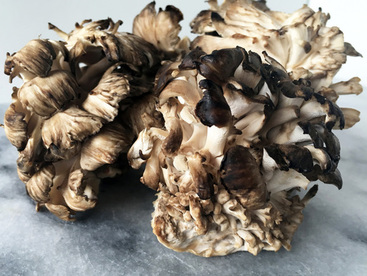 by Christi Lazar @bazaarlazarr , Contributing Editor to www.UglyProduceisBeautiful.org Hi, my name is Christi, and I was a contributor to the food waste problem in our country. “Bring me your chemically sprayed, overly shiny, and uncharacteristically clean produce,” was my operating motto for many years. If it wasn’t perfect, I wouldn’t eat it. “Oh, there’s a brown spot on that apple? Please put it back!” Shopping this way wasn’t done out of ignorance, I grew up on organic and natural foods. White bread was never allowed in our house, and I was the weirdo in school who had peanut butter that wasn’t a name brand. I guess you could say I knew better! But for me, food shopping had always been like online dating. A good profile picture goes a long way! It’s not until later that you find out the person on the other side of that picture is a total creeper! But once you realize things aren’t always as they appear, you take a closer look, and that’s where the journey begins. When I started learning more about food processing and agricultural standards, I knew I needed to change. Shopping at local farmer’s markets and incorporating organic fruits and vegetables into my cooking, I discovered that imperfect produce tastes just as good as pretty produce, and that eye appeal has nothing to do with the ability to create something healthy, delicious, and beautiful! Case in point the Maitake Mushroom aka Hen of the Woods. A couple of notes:
This ugly mushroom that I found wilting in the back corner of a produce bin turned into one of the most delicious slices of homemade pizza I’ve ever had! Check out my resulting Maitake Mushroom Pizza recipe! I spread a layer of ricotta cheese over the zucchini crust and sprinkled crushed red pepper over the top. Then I covered my layer of ricotta with Maitake mushroom pieces. I topped the whole thing off with crumbled goat cheese and Fontina, and baked it until the perfect level of melty-ness was achieved! My search for more ugly produce continues! Tune in next time for another harrowing tale of produce rescue turned delicious, healthy indulgence! Join UPIB and follow @UglyProduceIsBeautiful and @bazaarlazarr on Instagram.
0 Comments
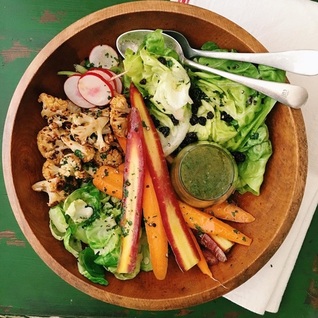 by Teri Turner, Contributing Editor to www.UglyProduceisBeautiful.org As winter turns to spring, it’s a time for new hope and new beginnings: a cause for celebration. I love it! I’ve been having so much fun! I’m especially enamored with the beautiful spring lettuces that remind me to recommit to savoring, appreciating and welcoming fresh produce back into our kitchen. And then there are artichokes: so tricky, yet so timely and versatile! With baby artichokes bursting out of the produce aisle of the grocery store, and with the local farmers market full of these magnificent treasures, it’s time to roast, poach, marinate raw, or add to a salad. My favorite is simply trimming, steaming, and serving with melted butter. I could eat them every night. Asparagus = Spring. Seize the moment! Wonderful shaved raw into a salad, broiled and finished with a bit of parmesan, or sautéed and blended for a soup, but a simple preparation of sautéing on the stove with olive oil and kosher salt is so scrumptious and feels so indulgent, in the best kind of way. And don’t even get me started on baby beets--I am crazy for them. Roasted whole, tossed in olive oil, then peeled and sliced, dressed in drizzles of olive oil, sherry vinegar, the juice of half an orange or Clementine, and if you want to go all out, add slices of pink grapefruit or avocado and even some toasted and slivered nuts. I’m swooning. I’m crazy about salads made with a combination of griddled, raw, and blanched vegetables. I picked up Hugh Acheson’s The Broad Fork, such a great way to celebrate spring--so many wonderful, updated ideas for eating in season. The combination of butter lettuce, griddled cauliflower, blanched brussels sprouts, other beautiful spring lettuces, sliced carrots, and a sprinkle of currants makes my whole body say “Hello, Spring!” This salad is a delectable, fresh, must-do! I particularly love his cider vinaigrette dressing. I stopped buying store-bought dressings years ago, as so many salad dressings are laden with unnecessary sweeteners. I prefer homemade, and my favorite technique is to dress the salad in the bowl once it’s all assembled. All I need are a few glugs of olive oil, a minced preserved lemon (which I always have on hand), a squeeze of lemon juice or dash of sherry vinegar and kosher salt. To add richness to a salad, I add crumbles of feta to the dressing. Spring is a time to get back into the kitchen and rekindle your love for your favorite vegetables, your body and your health. Join UPIB and follow @UglyProduceIsBeautiful and @nocrumbsleft on Instagram. 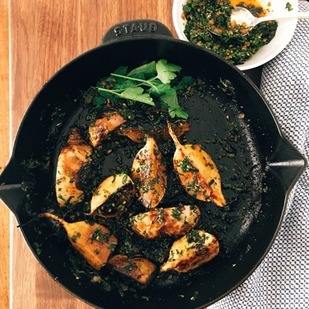 by Teri Turner, Contributing Editor to www.UglyProduceisBeautiful.org Turnips definitely fit into the “ugly is beautiful” category. The local, organic turnips that I am passionate about buying are not always the most beautiful. Without science and pesticides, the turnips may on the surface be “ugly,” but they are luscious, delicious, real food. It’s easy to be afraid of turnips and not quite know what to do with them, but roasting them in a cast iron pan in the oven and finishing them on the stove with some stock and Chimichurri will help conquer that fear. Chimichurri makes turnips so delicious and healthful! It’s versatile: spectacular served with roasted beef or tofu and a great way to use fresh herbs from your garden, or whatever you have left over in your refrigerator, so nothing goes to waste. I love cooking with my beautiful Staub cast iron pan, with its enameled, chip-resistant, natural non-stick-ish surface. I have to believe it’s better for my health than cooking with non-stick pans. This dish is inspired by Gjelina in Venice, California. If you like vegetable-forward, out of the box eating, then this is a must-have cookbook. I’ve been cooking up a storm so check out my blog nocrumbsleft.net for more inspiration! Two of my favorite genius ideas this month are the garlic confit and tomato confit. They are revelations that elevate everyday cooking. Heat the cast iron pan in a 450 degrees F oven until it’s super hot. Toss the turnips with olive oil and season with salt and pepper. Roast the turnips for about five minutes, then flip and roast the other side for five minutes, or until soft. Remove pan from oven and place on stove. Add a couple of tablespoons of stock and Chimichurri. Stir to combine. Then add another two tablespoons of stock and stir until the turnips are browned. You can make a Chimichurri any variety of ways using fresh herbs and olive oil. I chopped a bunch of flat leaf parsley and a bunch of fresh cilantro, then added a couple tablespoons of fresh oregano, although dried would be fine too. Mix in a finely chopped shallot, and toss in a half cup of olive oil. Add salt and pepper to taste, a tablespoon of red wine vinegar, and smoked paprika to taste (between a teaspoon and a tablespoon). Let the flavors meld for about a half hour at room temperature. It’s lovely served with protein, especially steak or tofu, and stays fresh for about five days in your refrigerator. Join UPIB and follow @UglyProduceIsBeautiful and @nocrumbsleft on Instagram.  by Sarah Phillips, Co-CEO and founder, www.UglyProduceisBeautiful.org, @UglyProduceisBeautiful and @food I'm sure most of have a vegetable peeler in our kitchen drawer. We're so used to peeling vegetables and throwing the peels away, that most of us may not know how nutritious they are. Mounds and mounds of vegetable peels and nutrition in the garbage! Besides Ugly Produce is all twisted and gnarly, making them difficult to peel - so the solution is to give up and throw away your vegetable peeler rather than throwing away most of the vegetable's vitamins, fiber, and antioxidants, that as the saying goes, "can do your body good!" Did you know that in most vegetables, the nutrition is in the peels. I don’t know when the cooking technique of peeling produce came into being with such a vengeance, but it is a common recipe instruction in American recipes. I know that many of us cooks and bakers have been taught to peel our carrots, potatoes, apples, cucumbers, beets, zucchini, eggplant, for examples, making it a laborious and time consuming affair, not to mention causing endless vegetable peel food waste. Maybe it stems from an old societal message for us to get rid of the dirt in our homes, and to distance ourselves from nature. The apple or potato peeler, known also as the vegetable peeler, was thought to have been invented in the 19th Century. http://inventors.about.com/od/kstartinventions/a/kitchen.htm Now I am beginning to see recipes for how to reuse the peels. But what about if we think another way - what if we just threw away our vegetable peelers, and didn’t peel our produce at all. Especially when cooking with Ugly Produce, with all of its twists and turns - it's going to be hard to peel some of these beauties from nature. What if we also buy organic and local, so we can help eliminate some of those fears about chemicals and waxes placed on from industrial farming? Maybe the vegetable peeler with an 'x" across it should be my new logo? Some Important Facts: -In the potato, there is a striking difference between peel and flesh. Did you know that the potato’s skin contains approximately half the total dietary fiber? -Apple peels are naturally rich in nutrients and fiber. In fact, peels contain 2−6 times more nutrients and insoluble fiber than the flesh of apples. -What many people don't know is most of the beneficial nutritional value of cucumbers stems from the peel. -A kiwi's fuzzy skin is also edible - it contains more flavonoids, antioxidants and vitamin C than the insides - and double the fiber. -Eggplant skin is also rich in chlorogenic acid, a phytochemical that boasts antioxidant and anti-inflammatory properties, and also promotes glucose tolerance. Although the eggplant interior contains chlorogenic acid, it's much more prevalent in the skin. -Researchers found that mango skin contains properties similar to resveratrol, which helps burn fat and inhibits the production of mature fat cells. Mango flesh extracts were also tested, but did not produce the same results, which suggests that one needs to eat mango skin in order to get this beneficial property. -All watermelon contains citrulline, which has antioxidant properties and converts to arginine, an essential amino acid that is beneficial to the heart, immune system and circulatory system. But most of that citrulline is found in the rind. Eating a rind might sound unappetizing, but it can be pickled (like a cucumber), or simply sautéed and seasoned. Or throw it in a blender with the watermelon flesh, and add some lime. -The University of Illinois Extension warns that you should always prepare zucchini with the peel intact, since the peel is the most nutrient-dense portion of the vegetable. (http://healthyeating.sfgate.com/nutrients-found-zucchini-6989.html) -Carrot peels are edible, even though a carrot's peel and its flesh are the same color is an indicator that the two parts of the vegetable have a similar nutritional value. However the highest concentration of phytonutrients is found in a carrot's skin or immediately underneath. http://www.livestrong.com/article/518814-should-carrots-be-peeled-or-are-they-more-nutritious-with-the-peel-left-on/ Only peel them if the skin is bitter, which happens more frequently in older carrots - so do a taste test - but the lesson here is to not don’t peel vigorously. . When carrots are treated with pesticides as they grow, the peel holds the majority of the chemical. Note that even if you wash them thoroughly, the pesticides are still present in the food. And if you chose to peel your produce, use the peels in making vegetable stock, along with bits from other vegetables. Mushroom stems, corn cobs, potato peels, etc. can all be used in stock as long as you strain it after cooking. Research: http://www.stack.com/a/fruit-vegetable-peel http://www.livestrong.com Join UPIB and follow @UglyProduceIsBeautiful on Instagram. |
UPIB BLOGWelcome to the Ugly Produce is Beautiful Blog where we discuss important topics. Archives
November 2016
Categories |
|
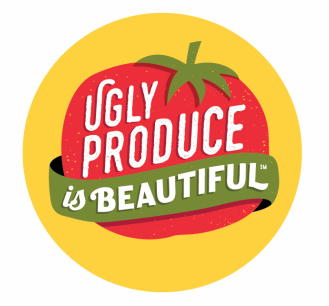
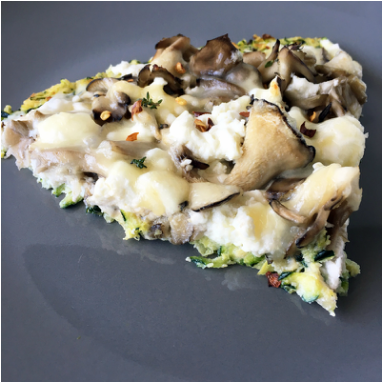

 RSS Feed
RSS Feed
